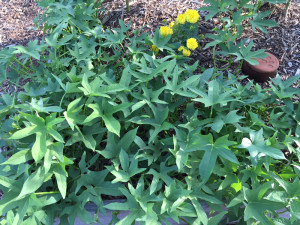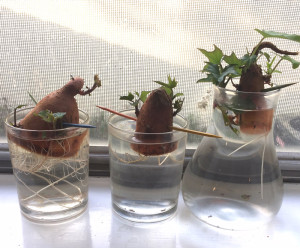Last year, I grew sweet potatoes for the first time. They are easy to propagate, low maintenance and produce beautiful leafy vine like leaves and purple flowers. My neighbor told me you could eat the potato greens but I never got around to trying it. I think the old saying that potato leaves are poisonous subconsciously made me disregard the idea. Sweet potatoes and regular potatoes are not from the same family and while the leaves from regular potatoes do contain a toxin that affects some people, the leaves from sweet potatoes are actually an amazing green eaten all over the world.
I finally decided to look into it since the sweet potatoes I planted at Adelphi had leaves starting to grow outside my plot and the vines were putting down shoots all over my plot. I realized I had to keep the plants in check and would regularly need to trim and use the leaves.
Sweet potato leaves, I discovered, are a highly nutritious green that can be used like spinach, kale or Swiss chard but with a milder taste. They have 3 times more B6 and 5 times more vitamin C than the actual sweet potato. The whole plant is so nutritious and such a good source of antioxidants, NASA has selected the plant to be grown in a controlled system as a primary food source. The leaves can be harvested repeatedly while the tubers grow, making it a dual purpose crop.
 As I discovered last year, sweet potatoes are easy to grow and can grow in poor, dry or wet conditions making them a great crop for beginners or gardeners with poor soil conditions. They are also tolerant of pests and disease. To propagate, all you need to do is cut a potato in half; submerge a portion of the bottom in water, place in a sunny location and wait for the slips to grow. Leafy slips will sprout and from all over and start growing roots. When they are big enough you just pinch the slip off and plant! You can start 10 or so new plants from half a potato.
As I discovered last year, sweet potatoes are easy to grow and can grow in poor, dry or wet conditions making them a great crop for beginners or gardeners with poor soil conditions. They are also tolerant of pests and disease. To propagate, all you need to do is cut a potato in half; submerge a portion of the bottom in water, place in a sunny location and wait for the slips to grow. Leafy slips will sprout and from all over and start growing roots. When they are big enough you just pinch the slip off and plant! You can start 10 or so new plants from half a potato.
Greens can be eaten raw in a salad or sautéed and added to an omelet, pasta or in anything you’d normally use spinach in. For my first attempt I decided to sauté them in some olive oil, shallots, garlic, salt and some of the abundant Juliet tomatoes I have on hand. Next I’m going to try some in a coconut curry with chick peas. If it works, I’ll post the recipe. If you’d like to try some feel free to stop by my bed number 9 and clip some leaves. They are growing outside the box and I could use the help keeping them trimmed!